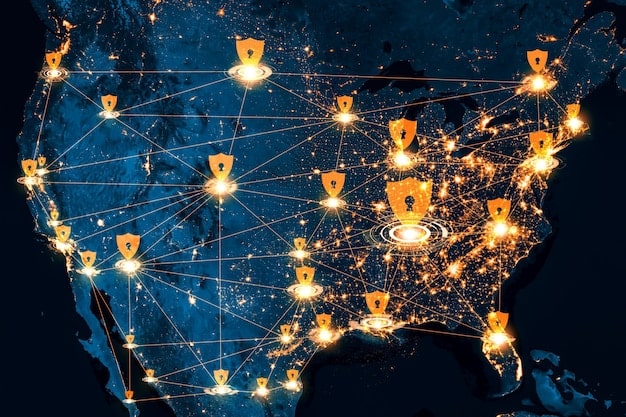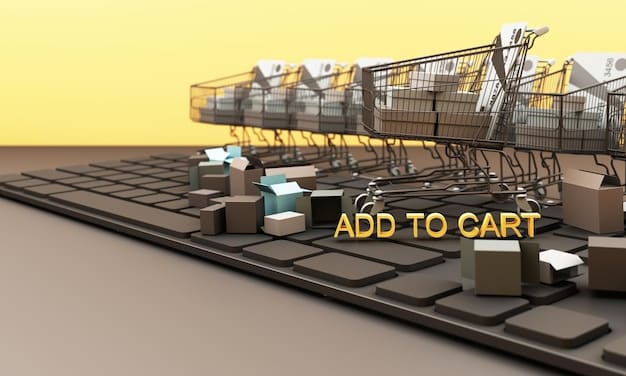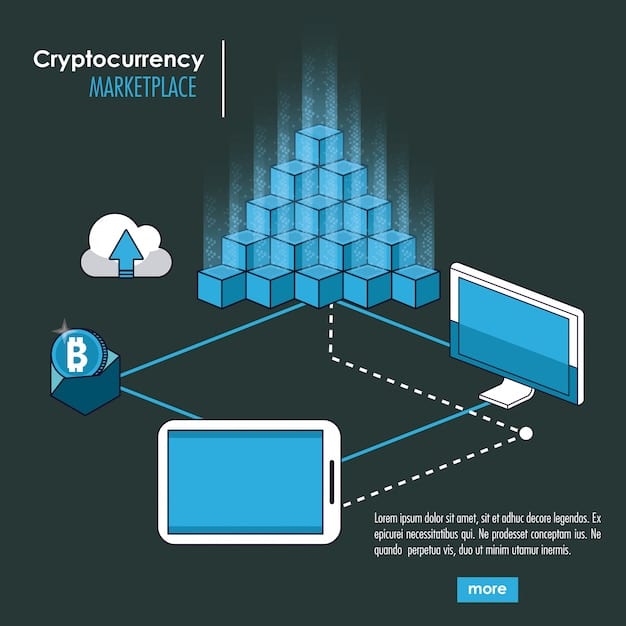Blockchain Revolution: US Supply Chain Transformation by 2025?

Blockchain technology has the potential to revolutionize US supply chain management by 2025, enhancing transparency, security, and efficiency, but its widespread adoption depends on overcoming scalability, regulatory, and integration challenges.
The integration of blockchain technology into US supply chain management by 2025 is a topic of much discussion. Is it a solution that will revolutionize the industry, or is it still too early to tell? Join us as we explore the possibilities and challenges of this innovative approach.
The Promise of Blockchain in Supply Chain Management
Blockchain technology offers a wide range of advantages that can dramatically improve supply chain management. From increasing transparency to enhancing security, the potential benefits are significant.
Enhanced Transparency
One of the primary advantages of blockchain is its ability to provide real-time visibility into the entire supply chain. This allows stakeholders to track products from origin to delivery, ensuring authenticity and reducing the risk of fraud.
Improved Security
Blockchain’s decentralized and immutable nature makes it highly secure. Each transaction is encrypted and linked to the previous one, creating a tamper-proof record. This security is crucial for protecting sensitive data and preventing counterfeit goods from entering the supply chain.
- Increased efficiency and reduced costs.
- Better compliance with regulations and standards.
- Enhanced trust among all parties involved.
- Improved inventory management and reduced waste.
The adoption of blockchain can lead to a more streamlined, secure, and transparent supply chain, providing significant benefits for businesses and consumers alike.
Current State of US Supply Chain Management
The US supply chain is a complex and multifaceted system that faces numerous challenges. Understanding the current landscape is essential to appreciating the potential impact of blockchain technology.
The US supply chain is one of the largest and most intricate in the world, involving a vast network of suppliers, manufacturers, distributors, and retailers. However, it is plagued by inefficiencies, lack of transparency, and vulnerabilities to disruptions.

Many companies rely on outdated systems and manual processes, leading to delays, errors, and increased costs. In addition, the lack of real-time visibility makes it difficult to track products and manage inventory effectively.
Several factors contribute to these challenges, including:
- Complex regulatory requirements.
- Global supply networks with multiple intermediaries.
- Lack of standardization and interoperability.
- Vulnerability to cyberattacks and data breaches.
Addressing these issues is critical for improving the competitiveness and resilience of the US supply chain.
How Blockchain Can Transform Specific Areas of the Supply Chain
Blockchain technology can be applied to various areas within the supply chain to address specific pain points and inefficiencies. Let’s explore some key applications.
Tracking and Tracing
Blockchain can provide a complete and immutable record of a product’s journey, from origin to delivery. This helps ensure the authenticity of products and prevents counterfeit goods from entering the supply chain.
Smart Contracts
Smart contracts can automate many processes within the supply chain, such as payment processing and order fulfillment. These self-executing contracts ensure that terms are met automatically, reducing the risk of disputes and delays.

Using blockchain technology it’s easier to optimize processes with end-to-end visibility:
- Simplifying customs clearance and border control.
- Improving logistics coordination and delivery times.
- Reducing paperwork and administrative overhead.
- Enhancing collaboration among supply chain partners.
By focusing on these areas, companies can leverage blockchain to create a more efficient, transparent, and secure supply chain.
Challenges to Blockchain Adoption in US Supply Chains
Despite its potential, the widespread adoption of blockchain in US supply chains faces several hurdles. Overcoming these challenges is crucial for realizing the full benefits of this technology.
Scalability is a significant concern, as traditional blockchain networks may struggle to handle the high transaction volumes required by large supply chains. Additionally, integrating blockchain with existing systems can be complex and costly.
Regulatory Uncertainty
The lack of clear regulatory guidelines for blockchain technology creates uncertainty and hesitation among businesses. Addressing these legal and compliance issues is essential for fostering adoption.
Lack of Standardization
The absence of industry-wide standards for blockchain applications can hinder interoperability and collaboration. Developing common standards is crucial for enabling seamless integration across different supply chain networks.
Other challenges must be dealt with. For Instance:
- High implementation costs and long payback periods.
- Resistance to change from entrenched incumbents.
- Concerns about data privacy and security.
- Need for specialized expertise and training.
Addressing these challenges requires collaboration among industry stakeholders, policymakers, and technology providers.
Potential Impact on the US Economy by 2025
If blockchain technology is successfully integrated into US supply chains, the potential impact on the economy could be substantial. Let’s explore some possible outcomes.
Increased efficiency and productivity could lead to significant cost savings for businesses. Reduced fraud and counterfeit goods could protect consumers and enhance brand reputation. Improved transparency and traceability could foster greater trust and collaboration throughout the supply chain.
Blockchain technology could have the following effects:
- Boosting US competitiveness in global markets.
- Creating new jobs in technology and logistics.
- Attracting foreign investment and innovation.
- Enhancing the resilience of critical supply chains.
The success of blockchain adoption will depend on overcoming the challenges and realizing the full potential of this technology. Furthermore, promoting sustainable and ethical practices in the supply chain could lead to social and environmental benefits.
Future Outlook: Blockchain in Supply Chain Management Beyond 2025
Looking beyond 2025, the role of blockchain in supply chain management is likely to continue to evolve and expand. Emerging trends and technologies could further enhance the capabilities of blockchain and drive adoption.
The integration of blockchain with other technologies, such as IoT, AI, and cloud computing, could unlock new opportunities for optimization and automation. For example, IoT devices could provide real-time data on product location and condition, while AI algorithms could analyze this data to improve decision-making.
Let´s consider the ongoing progress on the technological front:
- Growing demand for sustainable and ethical supply chains.
- Increasing adoption of decentralized finance (DeFi) solutions.
- Development of new blockchain platforms and protocols.
- Greater collaboration among industry stakeholders.
These trends suggest that blockchain will play an increasingly important role in shaping the future of supply chain management. As technology matures and adoption becomes more widespread, businesses can expect even greater benefits in terms of efficiency, transparency, and security.
| Key Point | Brief Description |
|---|---|
| 🚀 Transparency | Blockchain enhances real-time visibility in supply chains. |
| 🔒 Security | Immutable records and encryption secure supply chain data. |
| ⚙️ Efficiency | Smart contracts automate processes, reducing delays. |
| 🌎 Impact | Widespread adoption could boost the US economy substantially. |
Frequently Asked Questions
▼
Blockchain is a decentralized, distributed, and immutable ledger that records transactions across many computers. This makes it secure and transparent.
▼
Blockchain provides real-time tracking of products from origin to delivery. Every transaction is visible to all authorized participants, ensuring authenticity and accountability.
▼
Challenges include scalability, regulatory uncertainty, lack of standardization, high implementation costs, resistance to change, and concerns about data privacy.
▼
A smart contract is a self-executing contract written in code. It automates the terms of an agreement so that all parties can be certain of the outcome, improving efficiency.
▼
Through its secure and transparent nature, blockchain makes it difficult to introduce counterfeit goods into the supply chain. Every transaction is recorded and verified, reducing risk.
Conclusion
In conclusion, the integration of blockchain technology into US supply chain management by 2025 holds immense promise, offering enhanced transparency, security, and efficiency. While significant challenges remain, the potential benefits for the US economy and global competitiveness are substantial, suggesting that continued exploration and strategic implementation are warranted.





